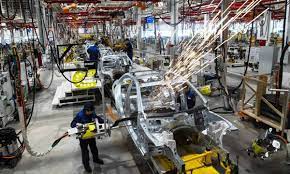The automotive industry comprises a complex network of companies producing and distributing automobiles. This vast system encloses car manufacturers and suppliers, retailers, and repair crews, all working together to keep our wheels turning. But the impact of this industry goes far beyond personal mobility. It fuels national GDPs, creates jobs, and fosters technological advancements, particularly in the crucial domain of sustainability. Yet, this engine’s full potential for development remains untapped in low-income countries. Affordable and efficient transportation can unlock possibilities in these low-income countries. Its economic importance and the unique perspective low-income countries offer unlock a fascinating journey toward revitalizing the automotive industry.
Current State of Automotive Industry in Low-Income Countries
The automotive industry faces considerable challenges in many low- income countries. While some assembly plants and used car markets exist, the overall situation could be more consistent and well-developed. This slow progress is due to various obstacles, each resembling a road bump on the path to advancement.
One significant hurdle is the limited purchasing power of the population. People and potential manufacturers struggle to find accessible financing. All these factors create a tough cycle, where a small market makes it unattractive for investment. It leads to further limitations on growth and opportunities. It’s like navigating a bumpy road that’s hard to pave for progress.
Challenges Faced by Automotive Industry in Low-Income Countries
Challenges faced in the automotive developing industry are all interconnected and can create a vicious cycle of underdevelopment. Addressing one challenge requires tackling others as well. For example, improving infrastructure might require increased investment, which in turn might necessitate access to more financing. Some of them include:
Limited financial resources and access to capital:
Low-income levels and limited access to financing for both consumers and manufacturers hinder investment. Thus, Banks hesitate to offer loans for car purchases or factory construction due to perceived risks.
Lack of infrastructure and technological capabilities:
Inadequate road networks, limited access to electricity and internet, and a lack of skilled labor impede production and distribution. Even if vehicles are assembled locally, poor infrastructure can significantly increase transportation costs and limit market reach.
Dependence on imports for automotive components and parts:
Reliance on imported parts increases costs, reduces local value creation, and makes the industry vulnerable. It creates currency fluctuations and trade disruptions. It limits the potential for job creation and economic growth within the country.
Inefficient regulatory and policy frameworks:
Unstable or unclear government policies, lack of optimal safety and environmental regulations, and bureaucratic hurdles discourage investment and innovation. It can create uncertainty for businesses and long-term planning.
Limited consumer purchasing power:
Low average incomes and limited access to credit restrict the size and potential of the domestic market for vehicles. Even if affordable vehicles were available, many people may not be able to afford them, further limiting demand and discouraging local production.
Policy Recommendations and Strategies for Development
Policy Push for Progress:
Governments can offer incentives like tax breaks and loan guarantees to attract investors and encourage local production. Clear and stable regulations prioritizing safety, environmental standards, and responsible business practices. These create a predictable and trustworthy environment for industry growth.
Building Bridges and Bytes:
Infrastructure is the very bedrock of progress. Upgrading and maintaining road networks connects markets, facilitates transportation, and unlocks regional economic potential. Embracing technological advancements like telematics, smart logistics, and electric vehicle charging infrastructure not only future-proofs the industry but also opens doors to innovation and efficiency.
Homegrown Power:
Developing local supply chains for automotive components reduces dependence on imports. Encouraging car assembly plants with technology transfer and knowledge-sharing partnerships with international players brings global expertise.
Global Gears:
Partnering with established automotive companies through joint ventures and collaborative agreements provides access to technical expertise. Building platforms for knowledge exchange through research partnerships, technology transfer programs, and industry conferences. These allow local players to learn from global leaders and adapt their own innovations.
Sustainable Speeds:
Investing in electric vehicle infrastructure and clean energy sources promotes environmentally friendly transportation and reduces pollution. Developing efficient public transportation systems and encouraging the use of micro-mobility options like bicycles and scooters offers affordable and low-emission alternatives for everyone.
Economic Impact of Revitalizing the Automotive Industry
A flourishing automotive industry contributes significantly to a nation’s Gross Domestic Product (GDP). From mechanics and assembly line workers to engineers and logistics experts, they create a diverse range of high- and low-skilled jobs. It reduces dependence on imports. Increased production, exports, and domestic spending, all add fuel to the economic fire. All of these lead to higher government revenue and pave the way for infrastructure, education, and healthcare investments. It increases the way for better living standards and families to break the cycle of poverty.
Conclusion
Adopting additive manufacturing is a sustainable strategy. Automotive manufacturers can reduce their carbon footprint by incorporating additive manufacturing. Also, employing environmentally friendly materials and manufacturing components in-house results in substantial time, cost, and resources efficiencies. Its environmental impact and advance towards a more ecologically sound future.




